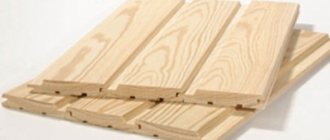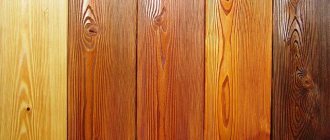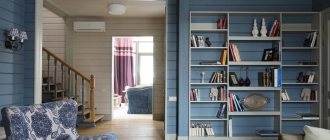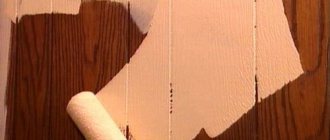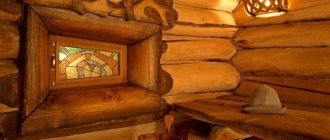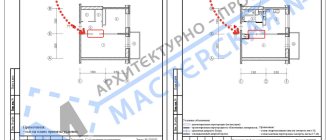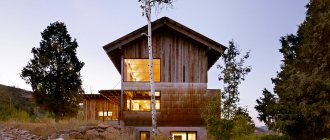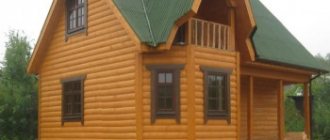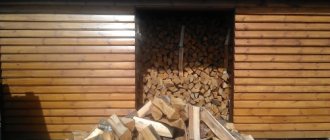Lining is a fairly common material today; designers use it to decorate interiors in Country style or in a marine theme. This material is durable and not expensive, but there is one drawback: over time, the lining requires updating, since due to temperature changes, humidity or abundant sun, stains appear on the wood and the material darkens. Let's look at ways to update the lining yourself.
Traditional methods
There are also folk tips on how to remove soot from lining in a bathhouse and steam room.
You can use a soap solution for this. However, this event will require a lot of time and effort. Additionally, improvised abrasive materials such as river sand or crushed brick are sometimes used. The surface must first be vacuumed. Then everything is thoroughly rubbed with soapy water. But in this case, you also cannot count on an ideal result if the surface is seriously contaminated. Therefore, sometimes you have to combine different methods and look for how to wash soot and soot from the lining in a bathhouse and steam room in more reliable ways.
Impregnations and coatings for lining on the balcony
In pursuit of cheap, practical building materials, we forgot about wood, which half a century ago occupied a leading position in construction. Now wood in a house is partly the roof, sometimes the floor, doors, furniture, and decoration.
For finishing residential premises, lining is used - lumber in the form of edged planed boards. Once upon a time, freight cars were sheathed with similar boards, which is where the name “lining” came from.
Due to massive deforestation and destruction of forests, the price of wood has risen. Not everyone can afford it. In addition, it is believed that wood requires special care and handling. But paneling on a balcony is not such an expensive solution: the area of the walls and ceiling for the cladding is small, and installation is easy to do with your own hands.
It is more difficult to process the lining on the balcony. But a balcony decorated with such material will look expensive and stylish! Every time you go out onto it, you will be able to inhale an indescribable woody smell.
Reasons for darkening of cladding boards
Unfortunately, residents encounter this problem quite often, in particular if they installed the boards themselves.
In this case, painting work is carried out with significant violations, which leads to deformation of the wood and the colonization of fungal and mold microorganisms.
Thus, the lining begins to gradually lose its original beauty, fills with moisture and begins to warp.
Therefore, very often owners, when sheathing a loggia, choose harmful and toxic plastic boards as an alternative to lining.
Know that any tree will begin to lose its color and along with it its attractiveness over time. This cannot even be affected by the product that was originally used to treat the darkened finishing material.
The following types of wood that have not yet darkened are used as cladding:
- Cedar shalevka (poorly tolerates temperature fluctuations and moisture).
- Linden (has good stability, but will lose color over time).
- Pine or larch (susceptible to atmospheric phenomena).
How to process lining
When covering a balcony with clapboards, it is necessary to treat not only the finishing with antiseptics, but also all the sheathing strips. The most popular protective impregnations and primers are listed below. Some of them can immediately give the wood a shade, not by painting, but by emphasizing the texture.
- Senezh Aquadecor is a tinting antiseptic. If you coat wood with this composition, it immediately protects against mold, fungi, and insects, while simultaneously imparting one of 16 shades. No finishing coat is required.
- Aquatex “Grunt antiseptic” is a high-quality protection for lining under subsequent finishing coatings (for example, varnish).
- TIKKURILA VALTTI-POHJUSTE (TIKKURILA VALTTI-POHJUSTE) primer antiseptic for wood, protects against biological damage, but does not protect against ultraviolet radiation. Therefore, prompt staining is recommended.
- Impregnation of the U-409 Estate. It creates a thin polymer film on the wood through which steam penetrates, but this film prevents dirt from penetrating into the wood, preserving the appearance of the finish. The composition includes additives that protect against fungi, mold and insects.
The packaging of each product contains instructions for use and application. It describes the rules of application and consumption to ensure protection. Only by following these rules can you be sure that the lining and the frame underneath will serve for a long time.
If we talk about stains, most modern compositions, while changing the color of wood, also have protective properties. For example, Aquatex stain (analogous to Senezh Aquadecor). It has a wide range of colors and contains a hard-to-wash antiseptic that protects the wood from damage by fungi or insects.
Processing the lining on the balcony can be done in different ways. It is most convenient to use tinting antiseptics for finishing the balcony. A single treatment will immediately protect and add color. But they only add tint, leaving the pores open. Dirt can accumulate in these pores. And cleaning it out is not an easy task. If you also need a protective film that will prevent the penetration of dirt, you can cover the lining (tinted or not) with varnish or dirt-repellent impregnation such as Usadba U-409. Impregnation creates a polymer film on the surface that closes the pores, but does not provide shine.
Problems often arise on the sunny side: how to cover the lining on the balcony so that it does not fade. A light tint that slightly whitens the wood is best. A light wall heats up less and is not afraid of fading. This clapboard cladding looks great.
If you want to have a shiny surface, you can use any varnish for interior work. Watch the video about the types and types of varnishes. It will be easier for you to understand what varnish to coat the lining on the balcony with.
Painting the lining on the balcony with ordinary paint is no longer relevant today. Why spend money on wood and then paint over its texture? Then you can immediately install PVC. So choose: tinting, varnishing, or both.
Preparing for painting
If it has been decided to varnish the shalevka, or paint it with acrylic paint, before starting the main process, the surface should be prepared accordingly.
First of all, we are talking about cleaning the lining from various types of contaminants. When the surface is clean, the shalevka is degreased with an alkaline solution. The next step is sanding. To perform this, you can use a flat pumice stone or an abrasive wheel. As a result of sanding, the shalevka loses all its protective properties, which means it needs to be coated with an appropriate antiseptic solution, which not only plays a protective role, but will also preserve all the properties of the paintwork.
When the preparation is completed, the lining can begin to be painted.
If you use classic varnish, it will preserve the original pattern of the lining and will not require additional decoration. If the coating is opaque and completely hides the wood grain, then to obtain an attractive and original appearance, you should take care of additional decorations, such as window and floor design elements.
What to do if the lining darkens
There is no need to disassemble wooden panels that have lost their natural appearance and install new ones. Craftsmen have come up with many ways to lighten wood. They use:
- oxalic acid,
- hydrogen peroxide,
- bleach.
There are special ways and means to correct the situation and preserve the natural structure of the tree. To this end:
- treat the surface with a brightening compound,
- cover it with varnish of a lighter tone,
- sanded
- paint.
Whitening agents:
- do not spoil the structure of the tree,
- non-toxic,
- harmless
- fireproof,
- give the material wear resistance.
All these whitening methods have not only advantages, but also disadvantages. When using brightening compounds based on active substances (chlorine, hydrochloric acid), in order to preserve their effect, the lining is coated with a light-colored protective varnish on top.
The greatest effect is achieved if the product is applied in several layers. The original appearance will not be achieved, but the exterior will improve significantly. Painting allows you to completely change the appearance of the surface, but the effect of the wood structure disappears.
The method of processing with sandpaper and further coating with acrylic makes it possible to return the lining to its former beauty and increase its resistance to weather changes. When processing the front surface, do not forget about the back side.
The use of an antiseptic will protect the wood from the development of fungus and mold, which cause darkening of the coating.
Application of water-based varnishes
Preparing the lining for varnishing
In order for the treatment of lining with water-based varnish to achieve the desired result, the wooden panels must be carefully prepared.
Before varnishing the lining, we:
- We clean the surface of the lining from dirt and dust.
- If necessary, sand the surface of the sheathing using either sanding paper or regular pumice.
Advice! Excellent results (mirror surface, as in the photo) are obtained by the wet grinding method: we moisten the lining before grinding, process it and let it dry.
Varnished wood after wet sanding
- We treat the wood with a primer - this will reduce the consumption of quite expensive varnish.
After the primer has completely dried, you can begin applying the varnish.
How to update darkened lining
Reasons for lost attractiveness
Blackening of wood is more common when finishing it yourself. Here, technological errors are made when working with wood, which leads to a change in the external attractive appearance and even the appearance of fungus and mold. And this is caused by the unfavorable influence of the environment. Sometimes darkening is caused by poor quality building materials.
However, even under all favorable conditions, any tree loses its attractiveness and freshness over time. Therefore, protection is necessary when using it as a finish.
You can restore the attractiveness of the lining in several ways: lighten it with bleach, cover it with brightening varnish, cover it with acrylic paint, having previously sanded the surface, or paint it.
The lining has darkened, how to lighten it
Don’t be upset about this, immediately dismantle the darkened lining and run to the construction center for a new finish.
Craftsmen from among the people have long invented and put into practice a lot of methods for lightening wood. The ingredients used are oxalic acid, bleach and water (ratio 1:10), and hydrogen peroxide. And manufacturers have not ignored this situation and have developed special bleaching agents that do not harm the structure of the wood. Moreover, these products are harmless, non-toxic, and increase the material’s resistance to fire and mechanical damage.
After bleaching the lining, a protective coating should be applied and preferably several layers of it to reliably preserve the new light surface. Of course, you won’t get the original appearance, but the surface will be significantly improved.
Here, for example, is one of the methods for bleaching a darkened surface with the ready-made product “Iney Prof”, “Neomid-500-T” or “Senezh”. The packaging of each product contains detailed instructions on how to bleach wood. Give it a try.
The workflow looks something like this:
Apply the product to the wooden surface with a brush for 10-15 minutes, and then rinse with warm water. The brightening effect is immediately visible. However, now the lightened surface must be primed and then varnished in 1-2 layers.
When working, you should take precautions: wear rubber gloves and a ventilated area. Information about types of lining
Information about types of lining.
Painting the lining
It will allow you to radically change the surface, however, the effect of the natural structure of the wood disappears.
First, you need to prepare the surface before painting. To remove all dirt, treat the finish with an alkaline solution. Now you should treat it with pumice, sandpaper or a grinding wheel. This removes the old protective layer from the material. By using classic varnish, you manage to preserve the unique structure of the wood and that’s where your finishing ends.
If you decide to use an opaque finish, you will lose the interesting texture of the wood. To improve the decor of the room, you will need to change the design of windows, doors and flooring.
lighten and varnish
How to cover the lining so as not to darken
To protect the wooden surface you need to use varnish. Which one to choose?
Polyurethane varnish protects wood from yellowing and fading in the sun.
Water-based coating is environmentally friendly.
Alkyd varnishes are suitable for floors, walls, and also for exterior surfaces. They are abrasion resistant.
Acrylic-polyurethane varnishes do not fade and repel moisture and therefore are successfully used in saunas, baths, baths.
Acrylic varnish, produced on the basis of water, can be glossy or matte, is safe for health, and is recommended for allergy sufferers.
Aqualak is colorless with a long service life; it is used for floors, walls, and ceilings.
The article “Types of varnishes and their properties” will help you in choosing a varnish.
how to update darkened lining
Manufacturers of wood treatment products
Not all products on the market are of the highest quality. But there are a number of manufacturers who have been receiving positive recommendations from consumers for several years. Among the many offers on the market, the following brands of varnishes and wood paints stand out:
- Finncolor (Russia). Acrylate gloss and semi-gloss varnishes are easy to dilute with water while working. Pigments can be added to them. They are great for covering ceilings, walls, niches, door openings, and windows. Not for use on floors or furniture. The main function of protection is to stop the natural destruction of wood, to create a barrier when dirt, moisture, and harmful microorganisms (mold, mildew) get on the surface. Average costs - 1 liter per area of 5-12 square meters. m. Blend – 9 l. Approximate price – 2000 rubles.
- Composite (Russia). A quick-drying varnish without color or pungent odor is suitable for walls, ceilings, wood materials such as lining, non-laminated chipboard, fibreboard, OSB and MDF. One liter of product will cover an area of 8-12 square meters. m. Price for 1-3 liters – from 300 rubles, 10 liters – 2200 rubles.
- Commander (Finland). Varnishes with a ready-made coating of varying degrees of gloss. They are environmentally friendly, do not have a sharp specific odor, and can be used in children's rooms. The layer of varnish on the lining easily repels dirt and water and does not absorb fats. Consumption – 1 liter per 8-12 square meters. m. Small containers of 0.9 liters priced from 350 rubles. Medium (2.7 l) and large (9 l), respectively, cost more.
- Eurotex (Russia). The “Sauna” modifier is an ideal solution for rooms with high humidity. The product is used for bathrooms lined with lining, kitchens, baths, saunas. The composition contains wax, densely distributed over the surface, capable of withstanding high temperatures and humidity. The average price for 2.5 liters is 500 rubles.
- Colorex (Sweden). “Panellac” is an excellent primer for processing lining from new boards and an ideal finishing coat for already finished euro lining. Can be used on walls, ceilings and even furniture. Well protects wood from discoloration and aging, scratches due to mechanical stress. It has a hardening effect on wood. For 8-14 sq. m. only 1 liter is spent. Cost for 0.9 l - 750 rubles, 2.7 l - 1800 rubles, 9 l - 5000 rubles. “Supisauna” is an effective matte varnish for rooms with high humidity. Protects the lining from rot and darkening. Prices - 600-4000 rubles, depending on the volume of displacement.
- Belinka (Slovenia). Due to the fact that there are no biocides in the composition, the paint can be used inside the house. Thin-layer and colorless coatings are suitable for wood. They only give a matte shine. Very economical consumption - for 3 layers of 10-12 sq. m. area is enough for 1 liter. The approximate cost for 1-2.5 liters is from 600 rubles.
- Pinotex (Estonia). The “Interior” collection was released specifically for treating surfaces inside the house. The impregnation is a transparent, odorless liquid that is easily distributed over the surface of the lining. Composition: alkyd resin, light-resistant pigments, water. Blend volumes – 1.3-10 l. Costs on average are 1 liter per 8-16 square meters. m. Price – from 650 rub.
Translucent varnish “Commander” Source ales-spb.ru
Belinka brightening varnish is applied in one layer over untreated lining Source bsm21.ru
Varnishes and paints are applied with a brush and a roller made of a fur coat. On large areas, the lining is processed using special pneumatic devices - spray guns. They allow you to distribute the product evenly by spraying.
Consumption! The amount of material spent depends on the quality of the board, the number of layers, as well as the primary processing. The very first layer will be absorbed fastest and most deeply. If the structure of the wood is too “porous”, then the varnish or paint on the first layer goes deep into the microspace between the fibers.
Impregnations
These compositions are distinguished by the fact that they penetrate deep into the structure of the material and do not create a film on the surface. Some of the solutions discussed below can be used as a full-fledged protective layer, others can only be used as preparation for finishing.
The most popular options are:
Stains give the surface a certain shade, but do not protect it from water and other influences. The compositions can be water-based, alcohol-based or oil-based. They differ in properties, but perform the same function. The choice depends on the specific conditions, but the most popular are water-based solutions; they are distinguished by their low price and safety;
Before covering the lining with stain, you should choose the desired color
Acrylic-based impregnations are often called glazes. They differ from stains in that they tightly close the pores of the wood, so they can also be used as a finishing finish. If you are thinking about how to cover the lining to prevent it from darkening, then this option will come in handy. Acrylic emulsion reliably protects against ultraviolet radiation, and the surface retains its original color for a long time;
If you are thinking about how to cover the lining outside the house, then choose acrylic compounds with wax, they are especially reliable
How to cover the lining outside the house or inside the premises to protect them from mold? Antiseptic compounds provide excellent protection against fungus and extend the life of wood significantly. Such solutions are used exclusively as a preparatory layer; the surface is always covered with something again;
Antiseptic impregnations can tint wood to the desired color
If you are thinking about the best way to coat eurolining in order to increase its resistance to fire, then the best option would be special fire retardant compounds. They also serve as a preparatory layer before the main coat. A universal fire-bioprotective solution can be an excellent solution; it makes the material resistant to both fire and mold.
Universal formulations are very popular
Whiten (tint)
For a long time now, you can find products for whitening lining on the market. These are all kinds of impregnations or aqualacs that dry quickly, are odorless and fireproof.
There are a lot of “bleaches” for lining, and instructions are always indicated on the container, so understanding the processing process will not be difficult. As a rule, bleach is first applied to the wood and then washed off with warm water after 10-15 minutes (as indicated in the instructions). The wood will lighten before your eyes. However, this is only the first stage. After this, a primer is applied to the lining, and then varnish.
Varnishes are usually used when they want to preserve the color of the wood. They come in glossy and matte finishes and are UV resistant. Most often, acrylic varnish is used, which levels the surface and protects the wood from fungi and mold. Some summer residents cover the lining with a light tint varnish. The shade of the wood will become lighter, although the original color will not return.
Tip: choose a matte varnish; a glossy one will attract more attention.
Painting wood while maintaining texture
A pronounced wood pattern can be achieved using glaze, pigmented oil or wax. These compounds apply quite tightly, almost painting over the structure of the wood fibers. Any of the compositions described above can be applied with a brush or roller.
When applying paintwork materials, take very little, first applying them in fragments along the entire length of the lining. Then, using a brush or roller, the applied strokes are shaded over the entire surface. After leaving them to soak for 5-10 minutes, to reveal the texture, take a soft, lint-free cloth and remove most of the oil. As a result, the pattern appears much brighter than in its original state: a larger amount of pigmented product is retained in the grooves, and almost none remains on the protruding parts. The result is a pronounced texture. This technique is also called brushing or texturing the lining. In interiors, wood processed in this way looks very decorative: both on the walls and on the ceiling.
The process can be observed in the video. Three samples were painted: two with the same oil with pigment, one with colorless. 5 minutes after painting, one of the pigmented blanks is wiped to reveal the design. To preserve the wood after the pigment has dried (24 hours or more, read on the packaging), the lining is coated with two layers of colorless oil (glaze, wax). In areas of intensive use, you can also coat it with matte varnish.
Tips for choosing a topcoat and interesting ideas
A wide selection of coatings allows you to choose absolutely any color and texture for the lining. In a country house, it is better to give preference to the most durable and unpretentious compositions that do not have to be updated frequently.
If the finish is new, then it is worth preserving its natural color and choosing transparent products for processing: varnishes, azures.
If the panels have many defects or an old coating, then thick, opaque paint is indispensable. You can improve the appearance of the base surface by removing the top layer of wood, but this is too labor-intensive and time-consuming.
Unusual combination of paint shades for lining
The colors and shades of the lining can be combined in the decoration of one room. This technique allows you to divide a spacious room into zones. Decorate or diversify the design, place accents.
Color accents in clapboard finishing
Due to the color of the finish, you can achieve some visual effects. Light shades expand the space, dark shades, on the contrary, make it smaller. The white ceiling looks higher than the brown one.
The color scheme for the lining can match the palette of shades used in the interior or contrast.
Harmonious combination of color palette of textiles and walls
Selection of protective composition
Various processing materials that are applied to wood not only protect it, but also improve its appearance. After all, when using various paints and varnishes, you can make works of art from lining with your own twist.
Before treating the lining on the balcony, experts pay close attention to the appearance of the object. Depending on whether it is glazed or unglazed, the choice of composition is made
If the balcony is glazed and protected from external factors such as rain, snow and sunlight, then you can use solutions for interior wood finishing. Well, if it is open, then it is treated with solutions for external treatment
It is also important to treat the wood with both a fire-retardant material and an agent that prevents rotting.
Restoration of varnished panels
The quality of the coating will depend on the degree of opacity required to obtain the walls. If you do not need to completely cover the wood structure, it is better to sand off the varnish and rub in the coating. You can use impregnation to preserve the wood texture .
Attention
If preservation of the structure is not required, then nothing needs to be removed. Acrylic paints with high adhesion adhere well to all surfaces and are quickly tinted to any shade. You can use polyurethane tinted enamel, but walls with such a coating will be very shiny, so this method is not for everyone.
Why does the lining darken?
Blackening of the cladding boards occurs quite often, especially in the case of carrying out construction work on one’s own. In this case, the wood processing technology is usually violated, leading to damage to the material by mold and mildew. As a result, the presentation of the wood becomes worse: it turns black, becomes saturated with moisture, and warps.
You can use different types of lining:
- cedar shalevka is very sensitive to sudden temperature changes and the effects of water;
- linden material is more stable, but also darkens over time;
- pine and larch respond equally to weather conditions.
A competent approach to solving the problem guarantees the strength and reliability of wooden cladding.
How much lining is needed to cover a balcony?
It is better to consider the algorithm for calculating the area of a room using the example of a 5x8 house, where we will cover the walls and ceiling with clapboard.
Next you need to calculate the square footage of one of the rooms. Let its length (a) be 5m, width (b) 4m, and height (c) 2.5m. And then everything was as we were taught in the school geometry course.
- Let's start with a long wall: multiply its height by length (ac) = 5x2.5 = 12.5 m2.
- The opposite wall will be the same size, so we simply multiply the result by two. 12.5x2=25 sq. m.
- Now, using the same principle, we find the size of the smaller wall (bc) = 4x2.5 = 10 square meters. Multiply by two. 10x2=20 sq. m.
- We multiply the length of the room by its width and get the ceiling area (ab) = 5x4 = 20 square meters.
- Let's summarize the data obtained from points 2, 3 and 4. And in addition, the square footage for finishing one room is 25 + 20 + 20 = 65 square meters.
We are trying to correctly calculate the area of the balcony
The calculation of the square of the balcony follows the same principle, only in this case, for convenience, it is better to divide each side into its constituent figures.
Take the appropriate measurements and calculate the area of the resulting figures using the formula.
Add it up and you get the balcony data.
Calculation of the required amount of material
How to calculate the amount of lining? First we need to know the size of the cladding material.
According to GOST, the thickness of a standard board should be 1.2-2.5 cm, length - 600 cm, and width up to 15 cm.
Panels up to 1.6 cm thick are used for interior decoration, and panels with a thickness of 1.8 cm are used for exterior work.
Knowing the width and height of the boards, we can also find out their square footage. For example, if their height is 600 cm and width is 9.5 cm, then the total area of the board will be 0.52 square meters.
To find out how many units of material will be needed to cover a room, divide its total area (walls and ceiling) by the area of one board.
You can also contact a consultant at any building materials store for help or calculate using a special calculator on the manufacturer’s website.
It is recommended to take the material with a reserve in case of defects or breakage during installation.
Mechanical dismantling of lining
There is nothing complicated in the question of how to remove the lining, the main thing is to work carefully without damaging the planks. The tools you will need are a hammer, a thin, sharp, hard spatula and a well-sharpened nail puller. Dismantling begins with the lamella that was attached last, and most often it is not possible to maintain its integrity. From the wall, into the gap between it and the lining, you need to place a thin spatula and carefully pry off the lamella. It is necessary to pull it out from the mount slowly so as not to break the tenon and groove, because this will significantly complicate the re-installation process.
When the first lamella is no longer in place, the most crucial stage begins. In the area of fastening with a nail, the tip of a spatula is placed under the lining, and the lamella is moved back just a few millimeters with careful movements. Next, use a hammer, preferably a rubber one, so as not to damage the surface of the wood. With light movements near the nail head, the strip is pressed back to the wall, while the head remains sticking out 1-2 mm. This distance is quite enough to hook the nail with pliers or a nail puller. So, step by step, each nail in each plank is dismantled, freeing the wall from the lining.
If during installation the lamellas were secured with screws or clamps, the answer to the question of how to remove the lining becomes as simple as possible. In this case, the first plank is also torn off, and all subsequent ones are not moved away with a spatula, but are simply unscrewed using a screwdriver or screwdriver.
Processing lining in a bath to prevent blackening
In order not to wonder why the lining turns black in the bathhouse, what to do, you can prevent the process of damage to the board
The first thing people pay attention to when choosing a product is safety. Use indoors, especially in a bathhouse, implies the absence of toxic substances, the release of which increases with heat exposure
Among the natural remedies that are suitable for treating the inside of a bath, the most common are:
Treatment with compounds forms a thin, invisible film on the surface of the board, so the lining does not turn black even after years of active use and not very good ventilation. Before the finishing coat, it is recommended to treat the wood with an antiseptic solution based on boron salt. These compounds are harmless, suitable for use in damp and residential areas, and protect the lining from the formation of mold, mildew and blackening.
Classification of painting materials
Darkened lining can be painted with oil, alkyd or acrylic paints to restore the attractiveness of the surface. Let's look at the advantages and disadvantages of each type of paint.
Oil paints
They have an unpleasant odor and are painted in good weather so that the room can be ventilated.
The disadvantage is the loss of shine during long-term use, it is difficult to apply another type of coating on top of this coating, and the oily surface does not breathe.
Alkyd paints
They are used for walls and floors. However, they should be applied to a completely dry surface, otherwise bubbles will form and the paint composition will then peel off. The alkyd composition is resistant to moisture and its cost is low.
Acrylic based paints
Experts recommend using these paints for lining because of their many advantages.
Advice from experienced craftsmen
So we looked at the issue, the lining has darkened, what to do . To enjoy attractive lining longer, you need to know about the basic rules for using wood and follow them. To choose lightening, consult with specialists.
If you find an error, please select a piece of text and press Ctrl+Enter.
Source
Surface priming
Regardless of how you decide to treat the wooden lining, it must be primed.
For different types of wood, it is best to use special soil solutions. Today the most popular types are:
- Acrylic primer. It can be called universal, it is suitable not only for lining, but also for other materials, however, it is recommended to use it for processing indoors. On the street or open balcony, acrylic primer will not protect against exposure to an aggressive environment. Precipitation and high humidity can cause mold or darkening of the wood.
- Alkyd primer. This is a solution for treating wooden surfaces. The wide range of primers offered on the market will allow you to choose the ideal composition specifically for your lining.
- Polystyrene primer. This type of soil mixture is also designed for processing wood, but due to the toxic substances included in the composition, it is recommended to be used only in open areas.
Required materials and tools
Darkened areas of the material that are caused by external climatic factors can be lightened using a bleaching solution.
In addition to traditional methods in the form of bleach, hydrogen peroxide or oxalic acid, special compounds are often used that protect the natural structure and do not clog the pores of wood.
These mixtures are non-toxic and fire-resistant; they do not destroy the texture of the material, but increase its level of wear resistance.
Choosing material for cladding the balcony
Lining made from coniferous trees (cedar, larch, pine) is used for both internal and external cladding.
Pine wood is very durable, although its color may darken over time. In addition, thanks to resins, pine lining is not subject to rotting. Cedar boards are recognized as one of the most wear-resistant. However, its main drawback is its high cost.
The temperature on glazed loggias and balconies in hot weather sometimes rises to 50-60 C°. Therefore, if the balcony is located on the sunny side, pine and cedar lining cannot be used for external and internal cladding under any circumstances, because resin may be released on the surface of the boards when heated.
Eurolining made of hardwood (aspen, linden, oak, alder) is used in most cases for interior decoration of balconies.
The most budget options are alder and aspen. However, they do have minor drawbacks. Firstly, eurolining made from these types of wood may darken over time. Secondly, alder has relatively high thermal conductivity.
Linden lining is the most popular and, perhaps, ideal option for interior lining of a balcony. Linden wood has a pleasant light golden color that does not change over time.
In addition, you do not have to treat it with impregnations and varnishes. Linden lining does not overheat, does not swell and practically does not contain knots. In addition, it has high sound insulation properties. And this is especially true when it comes to a balcony.
What type of eurolining is suitable for a balcony?
There are three classes of eurolining:
- Grade A – these are boards with virtually no knots or core on the surface. The surface of class A eurolining has a uniform shade and is ideally smooth.
- Grade B means that a small number of knots are allowed on the surface, the size of which should not exceed 15-20 mm. These are high quality boards with good performance properties.
- Grade C – boards with knots up to 25 mm in size, blind holes, stripes and recesses.
If your budget allows, then it is better to use high-quality class A eurolining as upholstery, since it is most resistant to damage and harmful environmental factors.
Grade B is slightly inferior in performance characteristics to class A; it can be given a solid four plus. This type of eurolining is cheaper. In popularity it is not inferior to class A.
Class C boards, which are the most budget option, are used least often as a facing material for balconies.
It is definitely impossible to answer the question which eurolining is best for a balcony. After all, everything depends not only on the wood and type of material, but also on the climate zone, as well as on whether the balcony is located on the sunny side or not. Be sure to consider these factors.
How to clean the lining
Before you wash the wooden paneling, you need to select the means for this. To achieve the desired result and not damage the material, experts advise using special chemical cleaners or highly concentrated soot and soot removers.
When choosing special cleaning products, take liquid formulations and neutral degreasing gels. You can also use chemical sponges. They are impregnated with components of deep penetration action. Such substances immediately penetrate the wood structure and safely remove even the smallest particles of soot and soot. But such sponges become dirty and unusable in a short time, so do not forget to change the product in a timely manner.
- To clean the lining in the steam room and in the bath, take a sponge and a dry cloth, a container with clean water, a special product, a broom or vacuum cleaner, and plastic film. To clean ceilings and walls, you can use a mop with a soft cloth or sponge. Which mop is best to choose for your home, see here;
- First, clean the surface to be treated with a vacuum cleaner or broom;
- Prepare cleaning solution according to instructions;
- Apply the prepared composition to the darkened surface and thoroughly wipe the product with a sponge;
- After cleaning, rinse off the applied composition and any remaining product with plenty of water. During the process, cover the floor with film to prevent further contamination of the surface. After all, all the dirt drains down. Wash the floor last;
- Finally, be sure to wipe the paneling with a dry cloth. Otherwise, the raw wood will begin to rot.
Reasons why lining processing is required
If there is excess moisture, the wooden lining will rot. Untreated thin wood easily catches fire and is damaged by insects.
Its correct use will reduce risks. First of all, reliable waterproofing of the walls and insulation of the balcony with non-flammable insulating materials are necessary. The balcony should be well ventilated, to prevent the appearance of condensation, cold bridges, and sudden temperature changes.
Wood in any condition requires mechanical and chemical protection to ensure its safety. Wooden lining on a residential balcony requires particularly careful environmentally friendly processing.
Adviсe
- Do not use a thick layer, as it will blur and the service life will be short. It is better to paint in several thin layers.
- Use thin brushes in hard-to-reach places.
- Use a paint roller as it will not leave lint.
- Each product must be applied to the lining in several layers. Usually one or two, but it’s better to check with the store.
- When processing, move the brush along the board without tearing it off. Only the tips of the fibers should touch the lining. There is no need to press with great force.
It will be more difficult to update old lining on a terrace or on a cold balcony, so it is worth purchasing a special product that is resistant to temperature changes (how to beautifully cover a balcony or loggia with lining?). When processing building materials in a country house or in a heated room with normal humidity, no special requirements are imposed. It is enough that the materials to be painted are dry.
How to lighten treated wood?
If the coated lining has darkened over time, it is not so easy to lighten and repaint it; this is a long-term and complex process, therefore it is important from the very beginning to follow all the rules for performing painting and painting work when working with wood, so that you can then enjoy its beauty for a long time . But it's still possible
What should be done?
First of all, remove the old layer of varnish using all possible means. You can treat the paint layer with a heat gun, this is a good method, but there is a big drawback - the presence of a strong odor. You will definitely need a gas mask or powerful ventilation. It is less labor intensive. Restorator bleach in combination with a textured coating will help solve this problem. However, even in this case you will have to remove the varnish. If the varnish is water based, this will be easier to do.
How to paint the lining correctly?
There is a misconception that the most relevant option is to use oil paint. This is actually not true. If you use it to renew the shalevka, the surface of the wood will acquire an unnatural shine and will take a very long time to dry. Among other things, after a very short period of time, the shalevka will again lose its attractiveness and will require updating or even replacement.
It is much better to use acrylate paints and varnishes. They will not only provide an attractive appearance, but will also give the base material high protective properties from moisture, temperature changes, and, at the same time, allow the shalevka to “breathe.” It should be noted that the approximate service life of such a coating is 8-10 years. Then the whole process will have to start all over again, or replace the panels with new ones.
